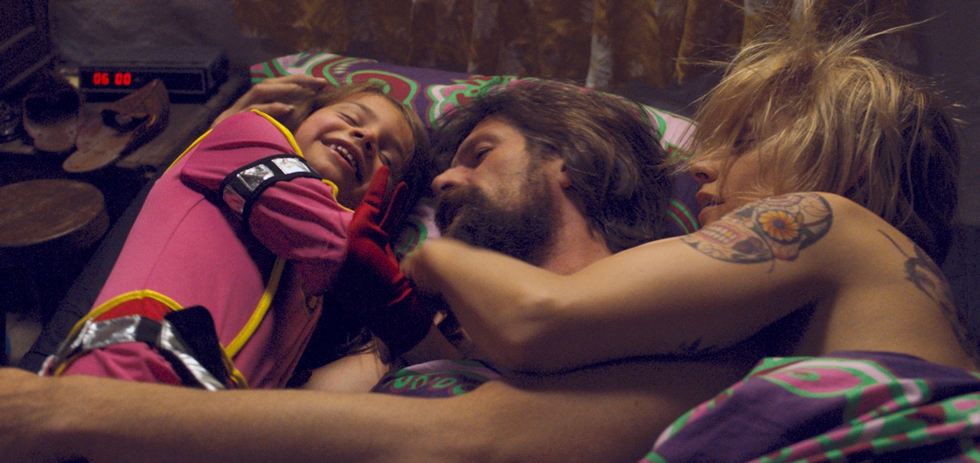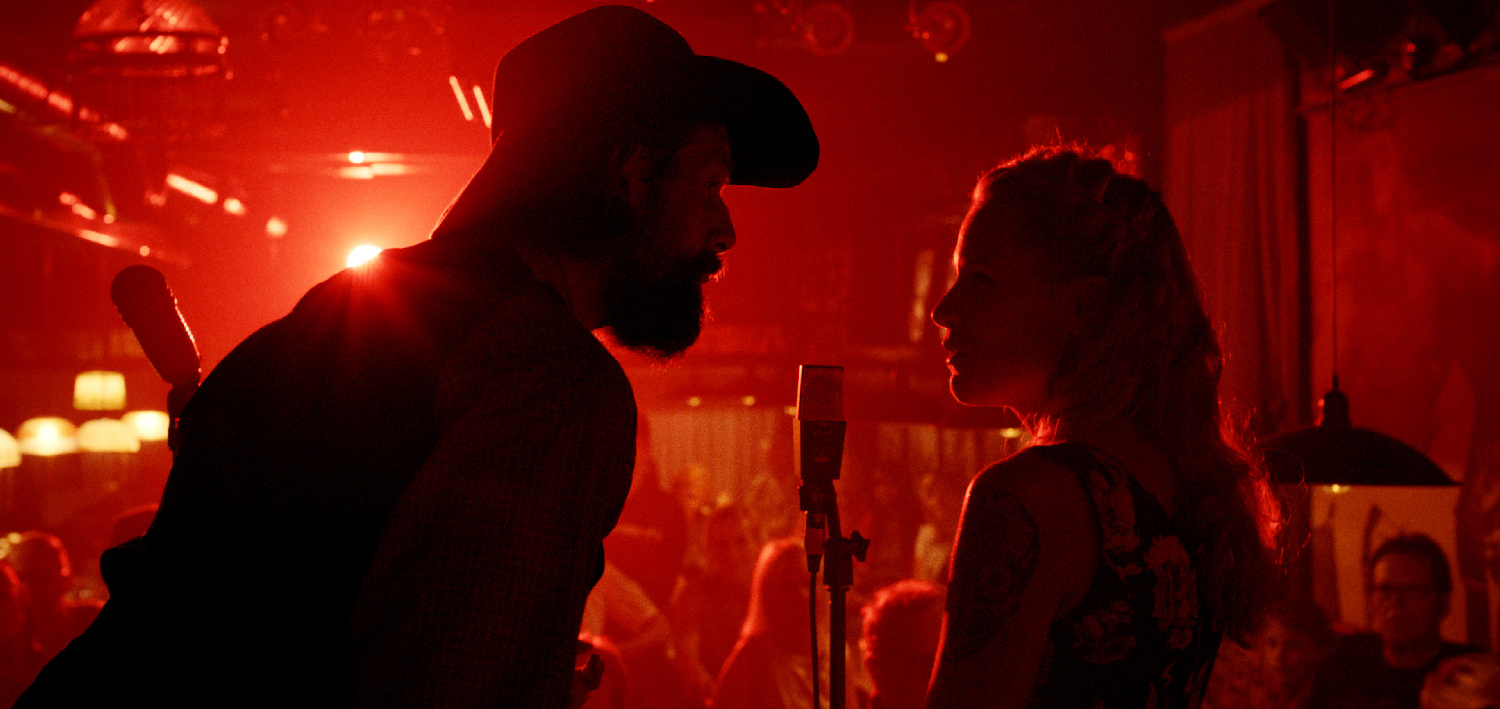
I first saw Felix van Groeningen’s The Broken Circle Breakdown a year ago and since then both the film and its great soundtrack have lodged themselves firmly in my mind. In short, I loved it the first time around, an intensely emotional film that somehow mastered a measured deviation of tone through music. I had to see the film again, in its domestic release here, because I wanted to make sure I hadn’t missed something. It seems a fair number of critics have had a different reading to me regarding the film’s final third or have rejected the way in which van Groeningen handled emotional beats, writing off the film as nothing more than shallow emotional manipulation. So here I am in this film’s defence and after a second viewing I find myself still strongly in that camp.
The Broken Circle Breakdown chronicles the disintegration of a family amidst tragic circumstances; bluegrass banjo player and presumed tradesman Didier (Johan Heldenbergh) and tattoo artist Elise (Veerle Baetens) are trying to hold it together after their young daughter, Maybelle (after Maybelle Carter), is diagnosed with cancer. The film is told through thematically linked flashback sequences, adeptly using dramatic irony for major emotional impact time and time again.1 There are musical performances throughout the film which serve as bookends to emotional chapters, ensuring that the film progresses not out of pure whim in the editing booth but with carefully ordered emotional waves. The back and forth nature of the film with regard to emotional impact seems to have been read by many as emotional manipulation and I reject that outright. Not only does the film telegraph quite early on what kind of narrative we are going to see, its usage of repetition of actions and motifs to allow deeper and more insightful moments ensures that the film is genuinely powerful. The emotion is of the film is not dependent on the crutches of melodramatic storytelling, as an allegation of emotional manipulation may suggest, but rather is derived from how real the characters seem and how willing van Groeningen is to let their flaws stand out.
The film is based on a play by Johan Heldenbergh (who plays Didier in the film) and Mieke Dobbels and the theatrical influence is apparent, particularly in regard to the musical sequences and the role of the band. Not only do the band act as a kind of audience surrogate at times, their appearance throughout the narrative is almost unreal and their seemingly spontaneous performances after tragedy don’t detract from the sequences but rather give them an overwhelming quality.2 I was also able to note this time around, with a feeling of both joy and fear, that Jan Bijvoet, who plays Camiel Borgman in Alex van Warmerdam’s superb Borgman, is playing slide guitar in the band.3 I didn’t think I’d ever get to see Borgman smile, yet here it is.
The cutaway sequences to musical performances, including some songs stitched together out of multiple locations and scenes, were fantastic, with the beginning of each song signalling a thematic shift in the film. It’s one of the clearest, perhaps most blunt, films I’ve seen with regard to using music as emotional cues and it worked for me each time, perhaps in part because the songs themselves are so great. Not only does the musicality of the songs reflect the emotions of characters, the mostly traditional lyrics also have narrative reflections – the existential queries of “Will the Circle Be Unbroken?” and the layered pun of “Country in my Genes” to name a few.
The performance of “The Boy Who Wouldn’t Hoe Corn” essentially encapsulates the blossoming love between Didier and Elise in song. The dynamics and texture of the music both become thicker as new instruments are added and the imagery of the sequence matches this evolution. We cut from an intimate scene where Didier quietly strums his banjo in his caravan, with Elise joining in to sing, after brief hesitation, to a bonfire surrounded by the band jauntily playing the next section of the song and Elise at the edge of the scene, sipping a beer and laughing. Then, finally, we move to a stage in a bar, where the full band plays for an audience. There’s a shift in the band, though, Elise is now up front, singing duelling vocals with Didier, surpassing him in both passion and quality. We move to a quick shot on his face, he is in awe and disbelief, the merger of musical and romantic expression encapsulated in a few on-stage glances. This entire sequence is awash in warm hues, from the orange curtains reflecting outside lighting amidst the dim of the caravan to the bright bonfire between the performers to the orange/yellow of the stage, this time the light surrounds them, stagelight from the front and behind. Then the lights dim, we return to the feel of intimacy the caravan opening had both visually and musically (the music returns to one instrument accompanying vocals – this time a guitar). The song ends and they lean behind his hat to kiss, the romantic fulfilment of the longing glances at the start of the song. In short, van Groeningen, cinematographer Ruben Impens and editor Nico Leunen, notwithstanding the band themselves, created a microcosmic musical masterpiece in four minutes and twenty-seven seconds.
Another interesting example of the way in which it is able to infuse music with emotion is in the repetition of the theme song for Flemish children’s show Mega Mindy. Initially it plays in a hospital scene near the start of the film and acts as a sharp tonal contrast from the stuttering implosion of Didier yet later on the song appears as a comedic beat in a flashback sequence, used to convey Didier’s amusing disdain for the screechy and loud children singing this infectious repetitive pop song. The song then, which is not born of the film itself, is still able to make us experience both humor and intense sorrow simultaneously through the film swinging back around to existing motifs. Again credit should go to Leunen, who manages to cut the film in reflection of the changing moods of each song but who is also able to draw visual links between scenes – the glass of the terrarium echoed in the glass dividing hospital rooms, for instance.

One of the major thematic elements within the film that seems to get overlooked is the intersection between affectation and coping mechanisms, something which elevates Broken Circle above other quasi-melodramatic films. A fair number of reviews to the film have cited it as being overly “preachy” or political, mostly in reference to a speech by Didier on stage late in the film in which he rails against America. What this reflects, in my opinion, is an overly narrow reading of characterisation in the film. In the ranting scene, van Groeningen uses a long shot and distinct aural echo to reinforce the separation between character and film with regards to ideals and opinion, whilst earlier, in a somewhat jarring aside about 9/11, he uses quick cuts to a close-up of Elise’s face to contrast from Didier’s anger.4 Linking this to America as an affectation is quite simple – throughout the film, mostly in flashback sequences, we are shown Didier’s relationship with America, his one-sided love affair with the country by way of musical appreciation. From bikinis to cowboy hats to bandanas, the stylistic influence of America on the film’s costuming is unmistakable. This makes Didier’s coping mechanism, lashing out at American religious values as a way of both funneling anger and reinforcing his aesthetic and logical persona, all the more tragic; as he shouts and denounces this country and its culture, which the film doesn’t necessarily condone, he has dismantled his personal passion and by way of that, a seemingly affectatious love, after horrible tragedy. The shots of Elise’s face in this final performance prior to his rant links the sentiment here clearly to the earlier scene with the television. Didier can yell all he wants at a paying audience (both within and without the film) but van Groeningen acknowledges that his anger is misplaced – he cannot change the past and his persistence in coping this way is, in and of itself, illogical.
Through the layered construction of character, van Groeningen highlights contradictions within Didier. He is a strong-minded atheist, whose inability to comprehend the illogical often infringes upon his relationship with Elise, a subtle nod to the notion of love as merely a belief system. It also has an impact on how he interacts with his daughter – we see his mind and heart at odds over her simple notion that a dead bird she found has been reincarnated as a star. For Elise, seemingly the stronger of the pair with regards to grief, at least initially, her jumps to accusations and resulting self-hate by way of triggering arguments she knows will hurt her are tragic coping mechanisms. As she tattoos over the names of ex-lovers on her body, she finds herself unable to cope when she cannot merely do the same here. Both actors are revelations in this film, Johan Heldenbergh, who was memorable but not particularly noteworthy in van Groeningen’s The Misfortunates, is best at his quietest; small facial movements and physical reactions reflect much more on his character than any scene of yelling will. Veerle Baetens, who won the award for Best Actress at the European Film Awards for this film, manages to impress in scenes of intense emotion as well as in musical performance, which would appear to be no surprise considering her musical background, although her work in this film is worlds away from her output as part of the electro-pop band Dallas.5
The film is not without its faults. A plot point near the end of the film involving the changing of names doesn’t quite succeed in resonating emotionally, despite the fact that it acts as another futile attempt at change – altering their names as a means of moving on with their lives, yet the names (Alabama and Monroe) are still irrevocably tied to the American bluegrass identity. In addition to this, the film dabbles in experimental editing through a frantic nightmarish sequence near the end which sits uncomfortably when placed relative to the rest of the musical sequences in the film.
A film as much about perspective in tragedy as it is about the passion inherent in the performance of music as a career, The Broken Circle Breakdown is a rare and contentious breed. It is uncompromising when it deals with sorrow and never hesitates to use music to achieve those ends. I, for one, think it does so with skill and nuance; and that relegation to the status of “emotional manipulation” is an overly reductive criticism.
Around the Staff:
| Felix Hubble | |
| Jess Alcamo | |
| Brad Mariano | |
| Dominic Ellis | |
| Saro Lusty-Cavallari | |
| Dominic Barlow |
